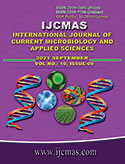


 National Academy of Agricultural Sciences (NAAS)
National Academy of Agricultural Sciences (NAAS)

|
PRINT ISSN : 2319-7692
Online ISSN : 2319-7706 Issues : 12 per year Publisher : Excellent Publishers Email : editorijcmas@gmail.com / submit@ijcmas.com Editor-in-chief: Dr.M.Prakash Index Copernicus ICV 2018: 95.39 NAAS RATING 2020: 5.38 |
Aims: To determine the prevalence of pathogenic bacteria causing urinary tract infections and their antibiotics susceptibility pattern from patients reporting in a tertiary care teaching hospital. Study design: Retrospective study. Place and duration of the study: Melmaruvathur Adhiparasakthi Institute of Medical Sciences and Research, January 2017 to December 2019. Methodology: 7825Mid-stream urine (MSU) samples collected for culture and sensitivity testing, sent to the laboratory during the period of study were included in this study. The samples were inoculated onto blood agar and MacConkey agar, incubated at 37°C for 24 hours. Identification of organisms by biochemical tests and antibiotic susceptibility testing were done by standard microbiological methods. Results: Out of 7825 samples, 3832 showed significant bacteriuria, of which 50% (1924/3832) were females. Escherichia coli was the most common pathogen isolated, which accounts for 41% followed by Klebsiella spp. (27%), Staphylococcus aureus (7%), Proteus spp. (7%), Acinetobacter spp. (5%), Pseudomonas spp. (4%), Enterobacter spp. (4%), Citrobacter spp.(4%), and Serratia spp. (0.9%). The antimicrobial susceptibility testing of Staphylococcus aureus showed 33% were Methicillin Resistant Staphylococcus aureus. The antimicrobial susceptibility pattern of gram negative bacilli showed high resistance to cephalosporins followed by carbapenems. Among gram negative bacilli, Klebsiella spp. showed 36% extended spectrum beta lactamases (ESBL) production. Conclusions: This study determines the trends in antimicrobial sensitivity patterns of uropathogens. It is helpful in the formulation of local antibiotic policy for the hospital and assist clinicians in the rational choice of antibiotic therapy to prevent misuse or overuse of antibiotics so as to prevent emergence of multi drug resistant pathogens.
 |
 |
 |
 |
 |